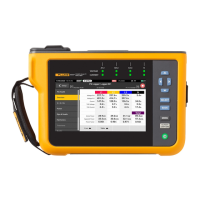1773/1775/1777
Calibration Manual
24
In the Setup tab, make sure the 177x has a COM port assigned and set the calibrator and DMM
control (the Voltage divider is not used for the adjustment procedure).
To do the adjustment:
1. Select the Adjustment tab of the 17xx_CalibrationTool. Choose Voltage, Voltage
Transient, AUX, or Current calibration for adjustment.
2. Click Start.
3. Follow the instructions provided in the automated procedure.
With completion of each measurement parameter adjust, the calibration factors are calculated
and stored in the Analyzer.
DC-Offset Calibration
With the instrument firmware V1.1 a feature has been added to automatically adjust the
temperature offset drift of the voltage measurement channels. Perform the DC-offset
calibration when the V
RMS
readings show a value of 0.5V or more at any time during the warm-
up time.
Note
The DC offset calibration is not mandatory for IEC 61000-4-30 Class A compliance. For
AC signals, the DC offset has negligible effect on the VRMS readings. If the AC voltage
has an RMS value of 100 V with a DC offset of even 1 V, the error of the VRMS
measurement is only 0.005 %. At 10 % of the applied AC voltage, the error is 0.05 V.
This is lower than the required maximum deviation of 0.1 V for IEC 61000-4-30 Class A
compliance.
To prepare the DC-offset calibration:
Confirm that the firmware V1.1 or newer is installed.
Make sure the Analyzer is powered from mains and the BP1770 battery is installed.
For best results, connect the voltage inputs L1, L2, L3 and N with the voltage input Earth.
Use the tilt stand to operate the Analyzer in the upright position
Make sure that the analyzer is not exposed to air flow.
To perform the DC-offset calibration:
1. From the Home Menu navigate to the Instrument Settings .
2. Select To o l s .
3. Select DC-Offset Calibration.
The message window shows information about the calibration:
has calibration been performed
internal temperature
Note
Instruments with a serial number above 5600001 are already calibrated in the factory.

